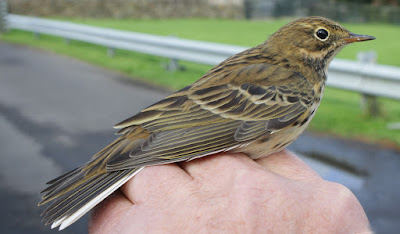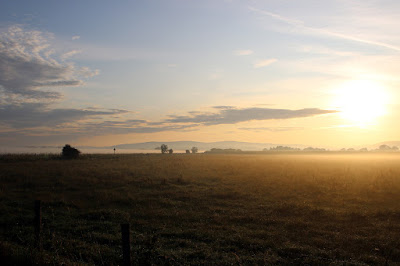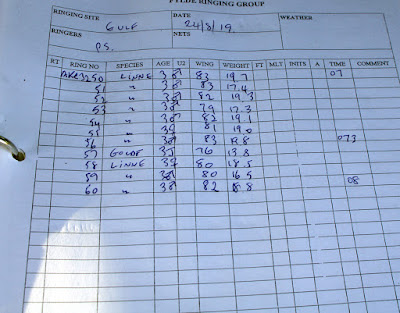As a light sleeper I’m often awake early. A look at the breaking dawn of Sunday revealed clear skies and no wind - a morning to revisit those darned Linnets that are up to their old tricks of playing hard to get.
If anything the Linnets are proving more difficult to catch than last season. There is such an abundance of food in the plot that the birds are free to land and to feed anywhere and it is not often they feed very close to the double net ride we established. The count was between 150 and 200 very flighty Linnets and a catch of just four, all males but including the first adult male of this winter’s project. To date we have 24 captures - 18 first year males, 5 first year females and 1 adult male. And to date, and as we might expect, no larger “Scottish” Linnets yet with all 24 birds recorded as wing lengths of 83 mm or less.
Linnet- adult male
At one point a male Sparrowhawk appeared and panicked the feeding Linnets into flight. The hawk seemed to have no trouble in identifying a Linnet to chase. After a brief flight the hawk caught the Linnet on the wing, dropped to the roadside, subdued the Linnet and then flew off carrying its meal. We lost a Linnet to a hawk and it’s for sure that this and similar flocks of birds will always attract predators. Such is the balance of nature.
Soon after the Sparrowhawk had flown the flock of Linnets panicked again when a Marsh Harrier appeared, flying slowly from the sea wall in the east and then over the busy A588 next to Gulf Lane. It followed the ditch, circled the seed plot once, flew lazily across the road, out towards the sea wall and on a direct path towards the plantation at Pilling Lane Ends. The harrier was all dark with no hint of grey in the wings and little or no cream crown - a youngster of the year.
Marsh Harrier
Less than two minutes later came another raptor following the same flight path alongside the still wet ditch that lines the seed plot. This bird was much paler than the previous and at first glance I assumed it would be a local Buzzard. But no, as the bird slowed, twisted, and held its wings in that diagnostic shallow “V”, it became another Marsh Harrier, this one a tri-coloured type with a cream crown, paler underneath and a well-marked area of grey in each wing.
This additional harrier was probably a second year male, perhaps even a family traveller in the company of the first bird a minute earlier. Within a few seconds it had drifted over the farm buildings and off in the general direction of Pilling village.
The Marsh Harrier is best described as “scarce” in this part of Lancashire so a sighting is always welcome, two even more so.
Marsh Harrier
The Marsh Harrier Circus aeruginosus is typically illustrated in field guides as a sexually dimorphic species, with several age classes identifiable by differences in plumage pattern and colour. In some populations, however, such as one studied in west-central France, (British Birds March 2013), the species can show extreme plumage variability in adult males and, to a lesser extent, in adult females.
The study population was markedly polymorphic, with highly distinct patterns of coloration and almost continuous individual variation between those different morphs. Barely a single adult male looked like a typical ‘field-guide male’. Since this plumage variability was independent of age and sex, the authors considered it almost impossible to age birds solely from their plumage, which contradicts the established view. The authors advocated the recognition of this species as polymorphic, at least in some parts of its range.
Back soon with more news and views on Another Bird Blog.






















































.jpeg)




.jpg)













